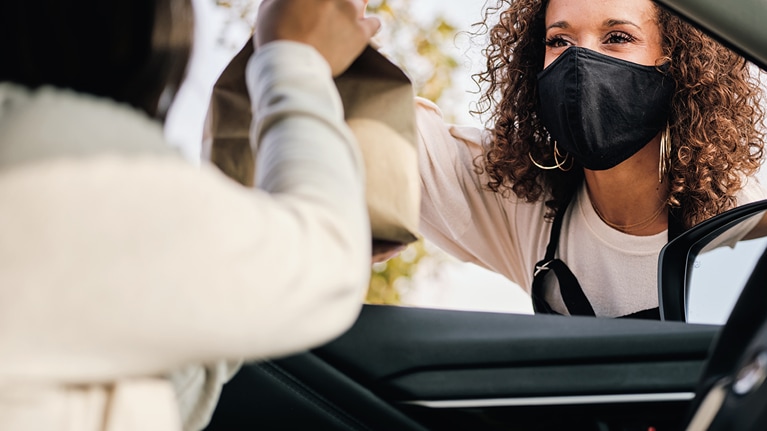The arrival of Alibaba’s Taobao Live in May 2016 marked the opening of a new chapter in sales. The Chinese retail giant had pioneered a powerful new approach: linking up an online livestream broadcast with an e-commerce store to allow viewers to watch and shop at the same time. Live commerce quickly established itself as a fixture in sales campaigns for Singles’ Day—a major shopping event in China—and, more broadly, as a reliable digital tool for boosting customer engagement and sales. In 2020, the first 30 minutes of Alibaba’s Singles’ Day presales campaign on Taobao Live generated an impressive $7.5 billion in total transaction value.1 Welcome to the next wave of the e-commerce revolution.
Live commerce combines instant purchasing of a featured product and audience participation through a chat function or reaction buttons. In China, live commerce has transformed the retail industry and established itself as a major sales channel in less than five years. In a 2020 survey, two-thirds of Chinese consumers said they had bought products via livestream in the past year.2 While retailers overall in the West are still behind China in the pursuit of live commerce, early movers are also starting to rack up significant sales.
How exactly this new channel will develop remains to be seen. What is clear is that it holds enormous long-term potential for brands and e-commerce platforms alike. If China’s experience is any guide, our analysis indicates that live-commerce-initiated sales could account for as much as 10 to 20 percent of all e-commerce by 2026.
How does live commerce create value?
Live commerce can help brands, retailers, and marketplaces primarily in two areas:
Accelerating conversion. Live commerce is entertaining and immersive, keeping viewers watching longer. It also telescopes customer decision journeys from awareness to purchase. Time-limited tactics such as one-off coupons can be used to generate a sense of urgency. Companies report conversion rates approaching 30 percent—up to ten times higher than in conventional e-commerce.

Improving brand appeal and differentiation. Done well, live commerce increases a brand’s appeal and distinctiveness and pulls in additional web traffic. It can strengthen positioning among existing customers and attract new ones, especially young people keen on innovative shopping formats and experiences. Some companies are seeing their share of younger audiences increase by up to 20 percent.
A rapidly growing channel
Live commerce has evolved rapidly in China, taking less than five years to develop into an innovative sales channel with an estimated penetration of 10 percent.3 The value of China’s live-commerce market grew at a compound annual growth rate (CAGR) of more than 280 percent between 2017 and 2020, to reach an estimated $171 billion in 2020 (Exhibit 1).4 This growth spurt has been intensified by the COVID-19 pandemic, and Chinese sales are expected to reach $423 billion by 2022.5
The product categories most often showcased in live commerce are apparel and fashion, with a 36 percent share, followed by beauty products and food, with roughly 7 percent each (Exhibit 2). Consumer electronics account for some 5 percent, and furnishing and home decor for almost 4 percent.6

In terms of demographics, Generation Z and millennials dominate, although live commerce is starting to attract middle-aged and more-senior consumers. By March 2020, live commerce was used by 265 million people—almost 30 percent of Chinese Internet users.7 Taobao remains the world’s biggest player (see sidebar “Key facts on the world’s biggest live-commerce player”), with a market share of 35 percent.8
Following China’s lead, Western brands, retailers, and marketplaces are establishing their own live-commerce ventures and events to promote their products, especially in beauty and fashion. Among the earliest adopters was German beauty retailer Douglas, which streams several shows a week in a range of formats, from workshops with experts to talks with influencers, and reports conversion rates of up to 40 percent.9 On the fashion front, Tommy Hilfiger recently extended its livestream program to Europe and North America following successes in China, where one show reportedly attracted an audience of 14 million and sold 1,300 hoodies in two minutes.10 And in December 2020, Walmart piloted a livestream fashion event on TikTok that netted seven times more viewers than expected and enabled it to add 25 percent to its TikTok follower base.11
A plethora of specialist start-ups have also emerged, including NTWRK, which features shows where guests talk about limited-availability streetwear, and Buywith, where viewers watch hosts browsing the e-commerce platform and chatting via webcam.
Meanwhile, consumer demand is building: a recent survey found that almost a quarter of adults outside China would like to discover new products via a livestream featuring an influencer or brand representative.12
Starting out in live commerce
While live commerce is still an emerging channel with many unknowns, some best practices are emerging, and lessons from e-commerce are proving to be applicable. Brands will need a thoughtful approach to learning how to use the medium—it can be expensive to do live commerce during Singles’ Day, for example, so best to try low-risk options first—and evolve their capabilities as they learn (see sidebar “Three live-commerce archetypes”).
Our analysis has shown that focusing on answering the following questions can help put brands on the right track.
Which product and audience?
Consider which stage a product has reached in its life cycle. Are you seeking to generate instant feedback on a new product, clear stock of an older item, or give a bestseller an extra boost? Our observations suggest that live events can be highly effective for creating awareness and prompting trial but less so for solidifying loyalty. It’s worth noting that many impulse shoppers are one-time buyers, so a newly attracted audience can’t be taken for granted; keeping it will take work. Similarly, our experience has shown that shoppers often come from a very different demographic than the brand’s typical target group.
To ensure that your show attracts the consumer segments most relevant to your brand, it’s critical to know who makes up your audience, what matters to them, and how to get their attention. Using analytics sources and tools to understand who has watched your content in the past can help you build up “personas” of potential customers to guide your choices on your target demographic. In broad terms, Generation X and Generation Z shop—and spend—more online than other groups, but it pays to dig into the data at a more granular level.
In fashion, beauty, and luxury goods, for instance, millennials are the top-spending cohort, with 31 percent of the US market, according to McKinsey analysis. Boomers come in second, with 25 percent, followed by Gen X at 24 percent and Gen Z at 20 percent. But category by category, the picture becomes more complex: Generation Z spends more on luxury apparel and accessories than millennials do, for instance (averaging $926 and $789, respectively).13
Knowing your audience also means knowing who and what most influence them. Adults in Gen Z derive 75 percent of their influences from social media, online content, and celebrities; millennials are a bit behind, at 63 percent, followed by Gen Z under-18s at 53 percent and Gen X at 49 percent (Exhibit 3). As these younger cohorts age, their spending power will grow, as will their presence. Millennials, for instance, are projected to account for half of the population globally by 2030.14

Product launches or presentations can attract attention to a new product and convert interest instantly into sales, making them a good choice for seasonal marketing campaigns and exclusive or special deals. To trigger impulse purchases, products need to look good on small and large screens and be positioned as good value for the money.
Which format?
To set up a livestream event, companies typically engage a key opinion leader (KOL) or key opinion consumer (KOC) to host the show, introduce the product, and interact with the audience to trigger sales. Several popular formats have emerged, each with its own strengths:
- Tutorials, such as makeup demonstrations hosted by models, are effective not only in showing audiences how to apply or use a specific product but also in suggesting how to combine it with other products, opening up cross-selling opportunities.
- Interviews with a big name or influencer from a relevant segment feel more personal, authentic, and genuine than product launches and can be good for building awareness and driving traffic.
- “Behind-the-scenes” videos offering the inside story of a product or company help build brand image and loyalty in a target segment—an ethical fashion retailer, for instance, might showcase its sustainable supply chain to environmentally and socially conscious consumers.
Regardless of format, many successful events feature interactive elements such as games, quizzes, and giveaways to keep viewers engaged and entertained. They maintain high production values in photography, location, lighting, and sound and ensure that scripts are not overly focused on the product.
Which enablers?
Planning a live-commerce event also involves deciding on the following:
- Technology. The key technology choice is which platform or marketplace to use for hosting the stream and providing e-commerce functionality. Some providers offer one of these functions; others, such as Instagram and Facebook, offer both. The right choice depends on a business’s level of maturity with live commerce. It also involves considering which technology provides the biggest target audience, which features it offers (live chat, “likes,” and so on), and the level of commission to be paid. Companies with more experience in live commerce can switch to an off-the-shelf solution, such as Livescale or Bambuser, that allows them to tailor the live-shopping experience to suit their brand, syndicate to multiple social-media channels, and offer their customers seamless purchasing from the same page. Companies that want to fully customize the customer experience and functionality often build their own solution.
- Tracking. As in e-commerce, effective monitoring and measuring of event impact by audience, day part, and so on is crucial to understanding what works and what doesn’t. It is important that the live-commerce operating model be flexible enough to act quickly on that data. After a show, for example, it’s possible to send a link to a recording of the show to a viewer who watched for just 20 seconds, or to offer someone who stayed for ten minutes a discount to convert their interest into a purchase. A one-off coupon code can help monitor customer behavior more precisely. Having this degree of flexibility requires a good content library, clear action plans and offer criteria, and a “continuous improvement” mentality.
- Marketing. Like any event, good marketing drives performance, and—as experience shows—companies often don’t invest enough time or resources to get their marketing right and can “starve” even the best marketing efforts. To maximize views, it’s crucial to take an omnichannel approach, alerting target audiences to an upcoming show through newsletters, emails, websites, apps, push notifications, and social media and providing links and information on paid social media. The best producers have an intimate knowledge of the features (such as countdown clocks) offered by the chosen livestreaming platform, and they invest the time to understand which websites their target audience frequents and place ads there.

Building an e-commerce business: Lessons on moving fast
What’s next for live commerce?
Our observations suggest we can expect to see the following developments in the next few years:
Micro- and nano-influencers. Big-name influencers and celebrities with millions of followers are expensive to hire and don’t always make the best hosts. Using influencers with a few thousand dedicated followers can generate a more intimate and trusted connection with audiences at lower cost. According to one survey, the engagement rates for nano-influencers on Instagram are ten times those for mega and macro influencers.15
Expansion into new sectors. As live commerce increases its reach, industries such as healthcare, engineering, finance—and, in time, B2B sectors—are likely to move in. For example, a leading tech company is planning to use its livestreaming platform to provide health-related content and services such as consultations and appointment scheduling.
Innovative formats. Augmented reality (AR) and virtual reality (VR) can make the shopping experience even more immersive and enable buyers to see a product from every angle. In an early example, Ulta Beauty teamed up with AR developer Perfect Corp to include virtual try-ons in its “Beauty School” livestream. In the future, consumers may be able to have virtual face-to-face conversations with a show host just as though they were speaking in a store.
Live commerce has become table stakes for successful consumer companies in China and much of the rest of Asia and is rapidly spreading to Europe and the United States. Some pioneers have achieved extraordinary reach and impact. Others wanting to follow their example will need to move quickly to design their own experiments to get the most out of this dynamic new channel.


